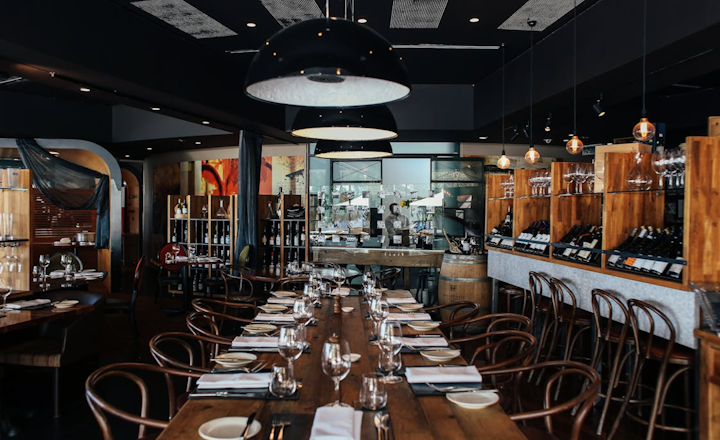
Image Source
We’ve all been there: you walk into a restaurant on a Friday evening, stomach rumbling, only to find yourself stuck in a long queue. The minutes drag on, you’re scanning the menu on the wall or your phone, and you’re wondering whether the food will be worth the wait.
For diners, it’s frustrating. For restaurant owners, it’s risky — too much waiting around can send hungry customers out the door. But here’s the clever twist: many restaurants are now turning long waits into golden opportunities.
Thanks to new technology, especially digital kiosks, what used to be dead time is becoming one of the most profitable and engaging parts of the dining experience. Customers aren’t just waiting anymore; they’re exploring, ordering, and even spending more before they’ve taken their seats.
Turning Waiting Time Into Ordering Time
Queues used to mean wasted time. Diners would stand around with nothing to do until a table freed up or a server was ready to take their order. Now, digital kiosks change the game completely. While waiting, customers can browse the menu, place their orders, and even pay upfront.
By the time they’re seated, the kitchen is already working on their food, which means meals arrive faster, tables turn over more quickly, and guests spend less time tapping their feet impatiently.
For restaurants, this has a direct impact on sales. Studies show that when people have more time to browse menus without pressure, they’re more likely to add extras: maybe a dessert they wouldn’t usually order, an extra side, or even a drink upgrade. Restaurants report higher average spends when kiosks are in use, and customers feel more relaxed because they’re not rushed by a busy server.
Did You Know: Restaurants often design kiosks to gently prompt upgrades. For instance, when you order a burger, the screen might suggest a combo with chips and a drink. Because it’s a screen and not a person asking, diners are more likely to say “yes” without hesitation.
More Accurate Orders, Less Stress
One of the biggest frustrations in dining out is when the wrong food arrives. Maybe the server misheard, or perhaps the noise in the restaurant made it hard to communicate. Digital kiosks eliminate much of that risk.
Customers input exactly what they want — from toppings and sauces to portion sizes and sides. This precision reduces mistakes, which saves time and cuts down on food waste. Kitchens love it because they get clear instructions, and customers love it because they get exactly what they ordered.
It’s also less stressful for staff. Instead of constantly double-checking orders or fixing errors, servers can focus on customer service, building rapport, and keeping the dining room running smoothly.
Did You Know: Some restaurants allow kiosks to save repeat customers’ favourite orders. This not only speeds up the process but also builds loyalty. Who doesn’t like tapping one button and getting their go-to meal instantly?
Upselling Without the Awkwardness
We all know that upselling is part of the restaurant business. Servers are often encouraged to recommend add-ons, larger portions, or specials. But let’s be honest: it can sometimes feel awkward. Not every customer likes being upsold face-to-face.
That’s where kiosks excel. They can suggest extras automatically and consistently, without the social pressure. The language is friendly, the options are clear, and customers are free to decide without feeling judged. And it works.
Data shows that kiosks often lead to more upsells than staff because the approach feels like a recommendation rather than a sales pitch. For instance, a kiosk might highlight a seasonal dessert or a limited-time cocktail that a customer would have otherwise missed.
Did You Know: Restaurants that use enticing images alongside suggestions see even higher sales. A picture of a gooey chocolate brownie is far more convincing than a verbal “Would you like dessert?”
Keeping Queues Moving Smoothly
When customers use kiosks while waiting, it takes pressure off the front-of-house team. Instead of servers juggling orders, seating, and payments all at once, they can focus on what matters most: delivering great hospitality.
This smoother flow means fewer bottlenecks at the till and shorter visible queues, which creates a better first impression for new arrivals. Even if the restaurant is busy, it feels more organised and efficient.
And let’s not forget about peak times. Lunch rushes, weekend dinners, or special promotions can overwhelm traditional ordering systems. Kiosks help absorb that demand, ensuring customers don’t walk away because the line looks too daunting.
Did You Know: Some restaurants position kiosks near the entrance, so even walk-ins can place an order quickly. This not only speeds things up but also reassures waiting customers that progress is happening.
Gathering Data That Helps Restaurants Improve
Here’s something many diners don’t think about: every order placed through a kiosk provides valuable data. Restaurants can track which items are most popular, what add-ons customers choose, and even how long it takes people to complete an order.
This information helps managers make smarter decisions, such as tweaking menus, adjusting stock levels, or tailoring promotions. For example, if a restaurant sees that a certain dessert sells particularly well when suggested on kiosks, they can highlight it more prominently in marketing campaigns.
Did You Know: Data can also reveal surprising habits. Some restaurants discover that customers often order a particular drink with a certain dish, giving them a chance to bundle the two as a “perfect pair” deal.
Building Customer Confidence and Loyalty
At the end of the day, customers want to feel in control. Kiosks give them that power: they can take their time, review their choices, and ensure everything is correct before hitting “order.” That sense of confidence goes a long way in creating a positive dining experience.
When people have a smooth experience from the start even if there was a wait they’re more likely to return. And because kiosks often link with loyalty programmes or apps, restaurants can reward repeat customers instantly, building long-term relationships.
Did You Know: Pairing kiosks with mobile apps creates an even smoother system. Customers can start an order on their phone and finish it at a kiosk or vice versa.
The Sales Power of Digital Kiosks
At the end of the day, restaurants aren’t just chasing faster service or happier customers — they’re also looking at the bottom line. And the numbers don’t lie: digital kiosks often lead to noticeable profit increases because customers tend to spend more when they order from a screen.
Without the pressure of a busy server waiting, diners take their time, explore the full menu, and are more likely to add extras. Think of it this way: when you’re at the till and there’s a long queue behind you, you rush. But at a kiosk? You’ve got the breathing space to say, “Actually, yes, I’ll add those loaded fries.”
Restaurants also save money by reducing order mistakes, which cuts down on food waste and the labour costs of re-making dishes. Fewer errors and smoother workflows mean kitchens can handle more orders per shift without adding extra staff.
Did You Know: Some fast-food giants have publicly reported double-digit percentage increases in average spend per customer after introducing kiosks. Independent restaurants may not see numbers that dramatic, but the uplift is still very real and often enough to cover the investment in the technology surprisingly quickly.
Bringing It All Together
Waiting for food isn’t going away anytime soon, but restaurants are proving that waits don’t have to mean wasted time. By using digital kiosks, they’re turning those tricky moments into opportunities for better service, stronger sales, and happier customers.
For diners, it means more control, faster service, and fewer frustrations. For restaurants, it means higher revenue, smoother operations, and a reputation for innovation.
So the next time you walk into a busy restaurant and spot a digital kiosk by the door, don’t roll your eyes, give it a try. Chances are, you’ll spend less time waiting, discover something new on the menu, and walk away more satisfied than ever




